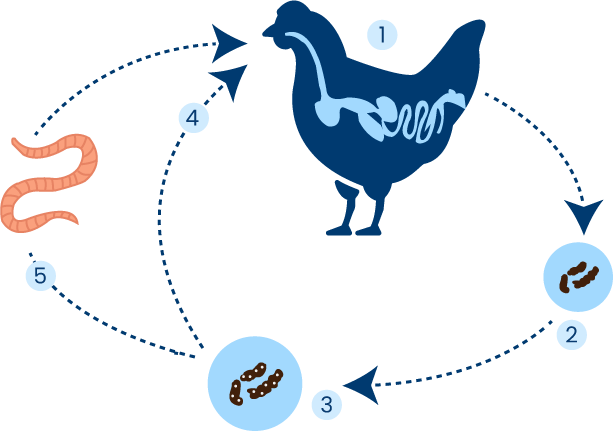Worm Infestation in Chicken
Parasitic worms affect intestinal and respiratory health in poultry, affecting farm performance. Modern practices such as improved housing, hygiene and management have reduced but not eliminated the incidence of parasitic infections. On the contrary, the risk increases as more birds are kept outdoor for welfare reasons. The infection rate in free-range birds is estimated to be more than 80% on average.
Parasites
Roundworms are one of the most common types of helminths that infect poultry.
These worms are found in the small intestine of infected birds.
- Ascaridia galli
- Capillaria
- Heterakis
Most birds display no obvious symptoms of infection.
- Eggs hatch in small intestine within 24 hours
- Eggs excreted with faeces
- Second and third larva stage larva develop in the eggs
- Direct - Chickens eat eggs with larvae from the soil or litter or contaminated water or food
- Indirect - eggs with larvae are eaten by earthworms as an intermediate host

Importance of parasite cycle
The eggs are resistant to desiccation, heat, and cold, and can remain viable in the soil for up to 10 years under favourable conditions.
The worms can have a direct life cycle (depending only on the bird host; Ascaridia) or an indirect one (with intermediate hosts in the environment; Capillaria and Heterakis).
The interval between the uptake of embryonated eggs from the environment and the re-excretion of new eggs (prepatent period) is 3-7 weeks depending on worm species. This interval forms the basis for an adequate deworming programme.
- The mean pooled prevalence was 79.4% ranging from 4 to 100%.
- Most common in chicken were Ascaridia galli (35.9%), Heterakis gallinarum (28.5%) and Capillaria spp. (5.90%). The tape worm Raillietina spp. (19.0%) was also fairly common.
- Chicken kept in backyard and free-range systems had a markedly higher pooled prevalence of helminth infection (82.6 and 84.8%, respectively) than those housed in cage production systems (63.6%).
Economic impact
Gastrointestinal parasites Ascaridia galli, Heterakis and Capillaria, are responsible for the most frequent and heavy economic losses in aviculture.
| Species | Type | Occurence | Cost of infestation |
| Capillaria spp | Hairworms | Crop, Oseophagus | €€ |
| High risk of infection worldwide | |||
| Ascaridia spp | Roundworms | Small intestine | €€€ |
| A serious problem worldwide, including on confined operations | |||
| Heterakis spp | Cecal worms | Cecum | €€€€ |
| Probably the most threatening worms in poultry operations worldwide | |||
Why is proper deworming frequency important?
A regular deworming schedule is recommended for all poultry with a production cycle of more than a few weeks or with free range, the treatment interval depends on two factors
- Pre-patent period(s) of the problem worm species: Treat infection before egg shedding occurs - breaking the lifecycle
- Infection pressure within the flock: With higher infection pressure (more eggs in the environment) a number of treatments at shorter intervals may be required to effectively reduce the worm burden
- Reference
Poult Sci, 2021 May; 100(5): 101082 PMCID:PMC8047976
Published online 2021 Mar 4. doi: 10,1016/j,psj,2021, 101082 PMID: 33813325
Global and regional prevalence of helminth infection in chickens over time: a systematic review and
meta-analysis
Anwar Shifaw, Teka Feyara, Stephen W. Walkden-Brown, Brenda Sharpe, Timothy Elliot and Isabelle Ruhnke

